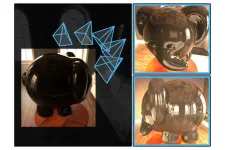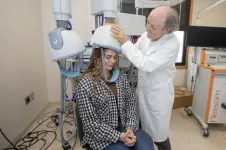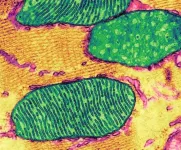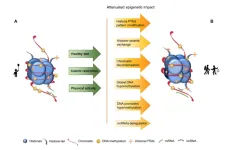(Press-News.org) As a car travels along a narrow city street, reflections off the glossy paint or side mirrors of parked vehicles can help the driver glimpse things that would otherwise be hidden from view, like a child playing on the sidewalk behind the parked cars.
Drawing on this idea, researchers from MIT and Rice University have created a computer vision technique that leverages reflections to image the world. Their method uses reflections to turn glossy objects into “cameras,” enabling a user to see the world as if they were looking through the “lenses” of everyday objects like a ceramic coffee mug or a metallic paper weight.
Using images of an object taken from different angles, the technique converts the surface of that object into a virtual sensor which captures reflections. The AI system maps these reflections in a way that enables it to estimate depth in the scene and capture novel views that would only be visible from the object’s perspective. One could use this technique to see around corners or beyond objects that block the observer’s view.
This method could be especially useful in autonomous vehicles. For instance, it could enable a self-driving car to use reflections from objects it passes, like lamp posts or buildings, to see around a parked truck.
“We have shown that any surface can be converted into a sensor with this formulation that converts objects into virtual pixels and virtual sensors. This can be applied in many different areas,” says Kushagra Tiwary, a graduate student in the Camera Culture Group at the Media Lab and co-lead author of a paper on this research.
Tiwary is joined on the paper by co-lead author Akshat Dave, a graduate student at Rice University; Nikhil Behari, an MIT research support associate; Tzofi Klinghoffer, an MIT graduate student; Ashok Veeraraghavan, professor of electrical and computer engineering at Rice University; and senior author Ramesh Raskar, associate professor of media arts and sciences and leader of the Camera Culture Group at MIT. The research will be presented at the Conference on Computer Vision and Pattern Recognition.
Reflecting on reflections
The heroes in crime television shows often “zoom and enhance” surveillance footage to capture reflections — perhaps those caught in a suspect’s sunglasses — that help them solve a crime.
“In real life, exploiting these reflections is not as easy as just pushing an enhance button. Getting useful information out of these reflections is pretty hard because reflections give us a distorted view of the world,” says Dave.
This distortion depends on the shape of the object and the world that object is reflecting, both of which researchers may have incomplete information about. In addition, the glossy object may have its own color and texture that mixes with reflections. Plus, reflections are two-dimensional projections of a three-dimensional world, which makes it hard to judge depth in reflected scenes.
The researchers found a way to overcome these challenges. Their technique, known as ORCa (which stands for Objects as Radiance-Field Cameras), works in three steps. First, they take pictures of an object from many vantage points, capturing multiple reflections on the glossy object.
Then, for each image from the real camera, ORCa uses machine learning to convert the surface of the object into a virtual sensor that captures light and reflections that strike each virtual pixel on the object’s surface. Finally, the system uses virtual pixels on the object’s surface to model the 3D environment from the point of view of the object.
Catching rays
Imaging the object from many angles enables ORCa to capture multiview reflections, which the system uses to estimate depth between the glossy object and other objects in the scene, in addition to estimating the shape of the glossy object. ORCa models the scene as a 5D radiance field, which captures additional information about the intensity and direction of light rays that emanate from and strike each point in the scene.
The additional information contained in this 5D radiance field also helps ORCa accurately estimate depth. And because the scene is represented as a 5D radiance field, rather than a 2D image, the user can see hidden features that would otherwise be blocked by corners or obstructions.
In fact, once ORCa has captured this 5D radiance field, the user can put a virtual camera anywhere in the scene and synthesize what that camera would see, Dave explains. The user could also insert virtual objects into the environment or change the appearance of an object, such as from ceramic to metallic.
“It was especially challenging to go from a 2D image to a 5D environment. You have to make sure that mapping works and is physically accurate, so it is based on how light travels in space and how light interacts with the environment. We spent a lot of time thinking about how we can model a surface,” Tiwary says.
Accurate estimations
The researchers evaluated their technique by comparing it with other methods that model reflections, which is a slightly different task than ORCa performs. Their method performed well at separating out the true color of an object from the reflections, and it outperformed the baselines by extracting more accurate object geometry and textures.
They compared the system’s depth estimations with simulated ground truth data on the actual distance between objects in the scene and found ORCa’s predictions to be reliable.
“Consistently, with ORCa, it not only estimates the environment accurately as a 5D image, but to achieve that, in the intermediate steps, it also does a good job estimating the shape of the object and separating the reflections from the object texture,” Dave says.
Building off of this proof-of-concept, the researchers want to apply this technique to drone imaging. ORCa could use faint reflections from objects a drone flies over to reconstruct a scene from the ground. They also want to enhance ORCa so it can utilize other cues, such as shadows, to reconstruct hidden information, or combine reflections from two objects to image new parts of a scene.
“Estimating specular reflections is really important for seeing around corners, and this is the next natural step to see around corners using faint reflections in the scene,” says Raskar.
The research was supported, in part, by the Intelligence Advanced Research Projects Activity and the National Science Foundation.
###
Written by Adam Zewe, MIT News Office
Paper: "ORCa: Glossy Objects as Radiance-Field Cameras"
https://arxiv.org/pdf/2212.04531.pdf
END
Using reflections to see the world from new points of view
A new computer vision system turns any shiny object into a camera of sorts, enabling an observer to see around corners or beyond obstructions.
2023-05-10
ELSE PRESS RELEASES FROM THIS DATE:
Stimulating hope: Personalizing treatment options for depression
2023-05-10
Artificial intelligence. Gene editing. mRNA vaccines. It’s safe to say the past few decades have felt like the next big wave of medicine. However, what continues to be needed in virtually every field is a personalized approach to care.
That’s certainly needed when it comes to using transcranial magnetic stimulation (TMS) to treat depression, said Medical University of South Carolina Distinguished University Professor Mark George, M.D.
TMS uses a magnet to increase brain activity in ...
Gene p16 drives colorectal cancer emerging as a target for potential therapies
2023-05-10
Colorectal cancer is the fourth most common and second deadliest cancer. How colorectal cancer develops is not well understood, but a team led by researchers at Baylor College of Medicine reports in the Journal of Experimental & Clinical Cancer Research that silencing the gene p16, even though the DNA itself does not change, can drive colorectal cancer progression in animal models. The researchers also revealed a strategy that reduced tumor growth and improved survival in tumor-bearing mice, opening new possibilities for future targeted therapies in patients with gene p16 alterations.
“Years of research have shown ...
New database offers insight into consequences of language loss
2023-05-10
New database offers insight into consequences of language loss
Languages, like animal species, can go extinct. More than half of the world’s approximately 7,000 signed and spoken languages are currently endangered. And without intervention they are likely to become extinct, meaning nobody will speak or sign them any longer.
While language loss is happening across the world, the costs vary strikingly in different places, according to a new study co-authored by Yale linguist Claire Bowern. Regions where all Indigenous language are endangered — including parts of South America and the United States — ...
Bigger isn’t always better: Size of research teams does not equate to better research outcomes, finds new study
2023-05-10
Having a large research team isn’t linked to producing higher quality research, finds a new study from the University of Surrey which analysed data from 1.4 million academic papers.
Professor Sorin Krammer, lead author of the study and Professor of Strategy and International Business at the University of Surrey, said:
“Despite the prevalence of large teams in research, there is still a lack of a good understanding of how their size and diversity affects their performance.”
“Our ...
The acute problem of chronic disease
2023-05-10
In medicine and science, the term “pathogenesis” describes the origin and development of disease. There is not, however, a broadly accepted term to describe the other half of the equation: the process of healing and recovery.
In a new and far-reaching paper, published May 10, 2023 in the journal Mitochondrion, Robert K. Naviaux, MD, PhD, professor of Medicine, Pediatrics and Pathology at UC San Diego School of Medicine, proposes both a term and, more importantly, outlines the array of processes and players, beginning with cellular mitochondria, that drive the healing process – and whose dysfunction underlies chronic illnesses from diabetes ...
An epigenetic approach to modulating aging with nutrition and exercise
2023-05-10
“In this review, we describe how aging impacts epigenetics and how nutrition and physical exercise can positively impact the aging process, from an epigenetic point of view.”
BUFFALO, NY- May 10, 2023 – A new review paper was published in Aging (listed by MEDLINE/PubMed as "Aging (Albany NY)" and "Aging-US" by Web of Science) Volume 15, Issue 8, entitled, “How can we modulate aging through nutrition and physical exercise? An epigenetic approach.”
The World Health Organization predicts that by 2050, 2.1 billion people worldwide ...
APL Photonics selects recipient for 2022 Future Luminary Award
2023-05-10
MELVILLE, N.Y., May 10 – The University of Arizona’s Husain Alqattan is the recipient of the APL Photonics 2022 Future Luminary Award for his work in utilizing pulse shaping and waveform synthesis to control electron motion and open the door for ultrafast electronics that process data at unprecedented speeds.
The winning paper, “Attosecond light field synthesis,” was published in the April 2022 issue of APL Photonics. In it, Alqattan and his team used an attosecond light ...
Using AI to predict important measure of heart performance
2023-05-10
Coronary heart disease is the leading cause of adult death worldwide. The coronary angiography procedure provides the clinical standard diagnostic assessment for nearly all related clinical decision-making, from medications to coronary bypass surgery. In many cases, quantifying left ventricular ejection fraction (LVEF) at the time of coronary angiography is critical to optimize clinical decision-making and treatment decisions, particularly when angiography is performed for potentially life-threatening acute coronary syndromes (ACS).
Since the left ventricle is the heart’s pumping center, measuring the ejection fraction in the chamber provides critical information about the percentage ...
Bleeding after image-guided breast biopsies: Discontinuing vs. maintaining antithrombotic therapy
2023-05-10
Leesburg, VA, May 10, 2023—According to an accepted manuscript published in ARRS’ own American Journal of Roentgenology (AJR), frequencies of imaging-apparent and palpable hematoma were not significantly different between patients temporarily discontinuing versus maintaining antithrombotic therapy (AT).
“The findings support safety of continuing AT during breast core-needle biopsy (CNB),” wrote lead researcher Melissa Reichman, MD, of Weill Cornell Medicine at New York-Presbyterian ...
Ohio State professor elected to National Academy of Sciences
2023-05-10
COLUMBUS, Ohio - An Ohio State University astronomy professor has been elected to the National Academy of Sciences, one of the highest honors a scientist can receive in the U.S.
David Weinberg, Distinguished University Professor and chair of astronomy, is among 120 new members and 23 international members from 13 countries who were inducted this year in recognition of distinguished and continuing achievement in original research inside their chosen field.
“I have been lucky to have great students and great colleagues throughout ...
LAST 30 PRESS RELEASES:
Making lighter work of calculating fluid and heat flow
Normalizing blood sugar can halve heart attack risk
Lowering blood sugar cuts heart attack risk in people with prediabetes
Study links genetic variants to risk of blinding eye disease in premature infants
Non-opioid ‘pain sponge’ therapy halts cartilage degeneration and relieves chronic pain
AI can pick up cultural values by mimicking how kids learn
China’s ecological redlines offer fast track to 30 x 30 global conservation goal
Invisible indoor threats: emerging household contaminants and their growing risks to human health
Adding antibody treatment to chemo boosts outcomes for children with rare cancer
Germline pathogenic variants among women without a history of breast cancer
Tanning beds triple melanoma risk, potentially causing broad DNA damage
Unique bond identified as key to viral infection speed
Indoor tanning makes youthful skin much older on a genetic level
Mouse model sheds new light on the causes and potential solutions to human GI problems linked to muscular dystrophy
The Journal of Nuclear Medicine ahead-of-print tip sheet: December 12, 2025
Smarter tools for peering into the microscopic world
Applications open for funding to conduct research in the Kinsey Institute archives
Global measure underestimates the severity of food insecurity
Child survivors of critical illness are missing out on timely follow up care
Risk-based vs annual breast cancer screening / the WISDOM randomized clinical trial
University of Toronto launches Electric Vehicle Innovation Ontario to accelerate advanced EV technologies and build Canada’s innovation advantage
Early relapse predicts poor outcomes in aggressive blood cancer
American College of Lifestyle Medicine applauds two CMS models aligned with lifestyle medicine practice and reimbursement
Clinical trial finds cannabis use not a barrier to quitting nicotine vaping
Supplemental nutrition assistance program policies and food insecurity
Switching immune cells to “night mode” could limit damage after a heart attack, study suggests
URI-based Global RIghts Project report spotlights continued troubling trends in worldwide inhumane treatment
Neutrophils are less aggressive at night, explaining why nighttime heart attacks cause less damage than daytime events
Menopausal hormone therapy may not pose breast cancer risk for women with BRCA mutations
Mobile health tool may improve quality of life for adolescent and young adult breast cancer survivors
[Press-News.org] Using reflections to see the world from new points of viewA new computer vision system turns any shiny object into a camera of sorts, enabling an observer to see around corners or beyond obstructions.





